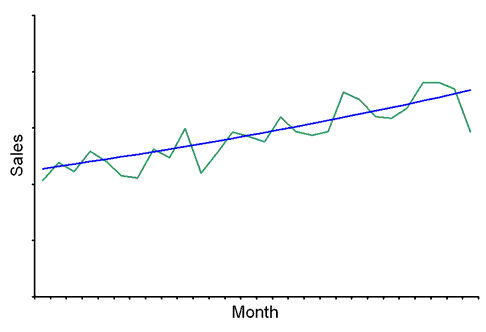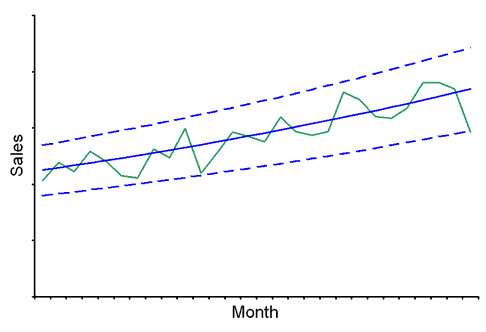

Forecasts are Always WrongForecasts are always wrong, yet they are a critical part of business planning, management, and strategy.That might sound gloomy, but it is reality, and there is an important trap here for business people to recognize. Statisticians know that every forecast has a certain error band around it, and would say that forecasts are accurate as long as the actuals come in within that range. But for your business, those bounds might be too wide. Depending on the business situation, the numbers could come in within that range and still cost you a lot of money -- or a lot of missed profits. The other trap for business people is that it is easy to develop too much confidence in the forecast, especially after investing time and money in expensive forecasting systems. Depending on the situation, this overconfidence can be very dangerous.  Take a look at this chart, which is a
monthly forecast of sales. The green line is the actual, and the
blue line is the forecasted amount using a simple regression line.
The forecast line seems to have done a good job of fitting the
trend, but the variance around the line is fairly wide. Take a look at this chart, which is a
monthly forecast of sales. The green line is the actual, and the
blue line is the forecasted amount using a simple regression line.
The forecast line seems to have done a good job of fitting the
trend, but the variance around the line is fairly wide.If you have forecasted selling 1,531 units of a product next month, what happens if it turns out to be 1,450? That's only a 5% error, but it could cost you in extra inventory if you planned on it being exactly 1,531. This could be especially costly if you're trying to reduce inventory on the product, as in a seasonal or end-of-life product. What happens in your business if the demand is really 1,600? Again, that is only a 5% error, but it could be very painful to have to give up on those extra sales if you planned for exactly 1,531. All forecasts are only accurate within a certain specific range, and that range will be different for different forecasts.  It's a good idea to put that range on the chart
when you're looking at a forecast just as a reminder of this
variance. This updated chart has error lines (the blue dotted lines)
at +/- 20% of the forecast. Without resorting to statistics, this
appears to be a pretty reasonable estimate of the error in this
forecast. When using this forecast, it would be important to keep in
mind that all you really know is that the actual sales for the
forecasted month are likely to be somewhere between the two dotted
lines. It is more likely to be near the center line, but it
could be anywhere in the range. (Actually, it could also be
outside of this range, but it is much more likely to be within
it.) It's a good idea to put that range on the chart
when you're looking at a forecast just as a reminder of this
variance. This updated chart has error lines (the blue dotted lines)
at +/- 20% of the forecast. Without resorting to statistics, this
appears to be a pretty reasonable estimate of the error in this
forecast. When using this forecast, it would be important to keep in
mind that all you really know is that the actual sales for the
forecasted month are likely to be somewhere between the two dotted
lines. It is more likely to be near the center line, but it
could be anywhere in the range. (Actually, it could also be
outside of this range, but it is much more likely to be within
it.)In general, business success is dependent upon maintaining the right balance between risk and reward in the important decisions. If you believe that the risk is lower than it really is, you could make poor risk/reward decisions. If you always start with the assumption that "the forecast is wrong", the next logical question is "how wrong". Then, you can go through the right thinking about whether that is acceptable for your business, and if not, what needs to be changed in either the forecasting methodology or the business. In manufacturing, we learned years ago that we could only improve the forecast so far, and that it was better to change the process than to try harder to get more accuracy in the forecast. So we moved many parts to automatic replenishment methods that weren't too sensitive to a bad forecast. Some times we were also able to design for postponement, in order to avoid errors in product mix. In other cases, we found that we had to build better forecasting tools. The first question, then, is "how wrong is it". Then, appropriate decisions can be made about 1) keeping errors from doing too much damage to the business, 2) deciding how important it might be to improve the forecasting methodology, and 3) identifying improvements to the business to make up for forecast errors.
|



